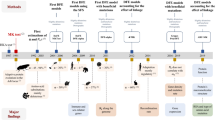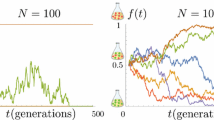Summary
The model of very slightly deleterious mutations was examined from the standpoint of population genetics in relation to the molecular evolutionary clock. The distribution of selection coefficients of mutants (in terms of amino acid changes) with small effect is thought to be continuous around zero, with an average negative value. The variance of selection coefficients depends upon environmental diversity and hence on total population size of a species. By considering various examples of amino acid substitutions, the average and standard error of selection coefficients and the reciprocal of population size are assumed to have similar values. The model predicts negative correlation between evolutionary rate and population size. This effect is expected to be partially cancelled with the generation time effect of intrinsic mutation rate. Implications of this prediction on the molecular evolutionary clock are discussed.
Similar content being viewed by others
References
Britten RJ (1986) Rates of DNA sequence evolution differ between taxonomic groups. Science 231:1393–1398
Chakraborty R, Fuerst PA, Nei M (1980) Statistical studies on protein polymorphism in natural populations: III. Distribution of allele frequencies and the number of alleles per locus. Genetics 94:1039–1063
Chang L-YE, Slightom JL (1984) Isolation and nucleotide sequence analysis of the β-type globin pseudogene from human, gorilla and chimpanzee. J Mol Biol 180:767–784
Dykhuizen DE, Hartl DL (1983) Functional effects of PGI allozymes inEscherichia coli. Genetics 105:1–18
Fisher RA (1930) The genetical theory of natural selection. Clarendon, Oxford
Fitch WM, Markowitz E (1970) An improved method for determining codon variability in a gene and its application to the rate of fixation of mutations in evolution, Biochem Genet 4:579–593
Giebel LB, van Santen VL (1986) Nucleotide sequence, evolution and expression of the fetal globin gene of the spider monkeyAteles geoffroyi. Proc Natl Acad Sci USA 82:6985–6989
Gillespie J (1984) The molecular clock may be an episodic clock. Proc Natl Acad Sci USA 81:8009–8013
Gillespie J (1986) Natural selection and the molecular clock. Mol Biol Evol 3:138–155
Goodman M, Koop BF, Czelusniak J, Weiss ML, Slightom JL (1984) The ν-globin gene; its long evolutionary history in the β-globin gene family of mammals. J Mol Biol 180:803–823
Harris S, Barrie PA, Weiss ML, Jeffreys AJ (1984) The primate ψβ1 gene; an ancient β-globin pseudogene. J Mol Biol 180: 785–801
Hartl DL, Dykhuizen DE (1985) The neutral theory and the molecular basis of preadaptation. In: Ohta T, Aoki K (eds) Population genetics and molecular evolution. Japan Scientific Society Press, Tokyo/Springer, Berlin, pp 107–124
Jukes TH, Holmquist R (1972) Evolutionary clock: non-constancy of rate in different species. Science 177:530–532
Kimura M (1968) Genetic variability maintained in a finite population due to mutational production of neutral and nearly neutral isoalleles. Genet Res 11:247–269
Kimura M (1979) A model of effectively neutral mutations in which selective constraint is incorporated. Proc Natl Acad Sci USA 76:3440–3444
Kimura M (1983) The neutral theory of molecular evolution. Cambridge University Press, London
Kimura M (1985) Diffusion models in population genetics with special reference to fixation time of molecular mutants under mutational pressure. In: Ohta T, Aoki K (eds) Population genetics and molecular evolution. Japan Scientific Society Press, Tokyo/Springer, Berlin, pp 19–39
Kimura M, Ohta T (1972) Population genetics, molecular biometry and evolution. In: Proc Sixth Berkeley Symp Math Stat Prob, Vol 5, pp 43–68
Kohne DE (1970) Evolution of higher-organism DNA. Q Rev Biophys 3(3):327–375
Laird CD, McConaughy BL, McCarthy BJ (1969) Rate of fixation of nucleotide substitutions in evolution. Nature 224: 149–154
Langley CH, Fitch WM (1974) An examination of the constancy of the rate of molecular evolution. J Mol Evol 3:161–177
Li W-H (1979) Maintenance of genetic variability under the pressure of neutral and deleterious mutations in a finite population. Genetics 92:647–667
Mani GS (1984) A Darwinian theory of enzyme polymorphism. In: Mani GS (ed) Evolutionary dynamics of genetic diversity (Lecture Notes in Biomath, Vol 53). Springer, Berlin, pp 242–298
Nei M (1983) Genetic polymorphism and the role of mutation in evolution. In: Nei M, Koehn RK (eds) Evolution of genes and proteins. Sinauer, Sunderland MA, pp 165–190
Ohta T (1972a) Evolutionary rate of cistrons and DNA divergence. J Mol Evol 1:150–157
Ohta T (1972b) Population size and rate of evolution. J Mol Evol 1:305–314
Ohta T (1973) Slightly deleterious mutant substitutions in evolution. Nature 246:96–98
Ohta T (1974) Mutational pressure as the main cause of molecular evolution and polymorphisms. Nature 252:315–354
Ohta T (1976) Role of very slightly deleterious mutations in molecular evolution and polymorphism. Theor Pop Biol 10: 254–275
Ohta T (1977) Extension to the neutral mutation random drift hypothesis. In: Kimura M (ed) Molecular evolution and polymorphism. National Institute of Genetics, Mishima, Japan, pp 148–167
Ohta T, Kimura M (1971a) On the constancy of the evolutionary rate of cistrons. J Mol Evol 1:18–25
Ohta T, Kimura M (1971b) Functional organization of genetic material as a product of molecular evolution. Nature 233: 118–119
Selander RK (1985) Protein polymorphism and the genetic structure of natural populations of bacteria. In: Ohta T, Aoki K (eds) Population genetics and molecular evolution. Japan Scientific Society Press, Tokyo/Springer, Berlin, pp 85–106
Sibley CG, Ahlquist JE (1984) The phylogeny of the hominoid primates, as indicated by DNA-DNA hybridization. J Mol Evol 20:2–15
Takahata N (1987) On the overdispersed molecular clock. Genetics 116:169–179
Templeton A (1985) The phylogeny of the hominoid primates: a statistical analysis of the DNA-DNA hybridization data. Mol Biol Evol 2:420–433
Templeton A (1986) Relation of humans to African apes: a statistical appraisal of diverse types of data. In: Karlin K, Nevo E (eds) Evolutionary processes and theory. Academic Press, New York, pp 365–388
Vogel F, Motulsky AG (1979) Human genetics. Springer, New York
Vogel F, Kopun M, Rathenberg R (1976) Mutation and molecular evolution. In: Goodman M, Tashian RE (eds) Molecular anthropology. Plenum, New York, pp 13–33
Wilson AC, Carlson SS, White TJ (1977) Biochemical evolution. Annu Rev Biochem 46:573–639
Wu C-I, Li W-H (1985) Evidence for higher rates of nucleotide substitution in rodents than in man. Proc Natl Acad Sci USA 82:1741–1745
Zuckerkandl E, Pauling L (1965) Evolutionary divergence and convergence in proteins. In: Bryson V, Vogel HJ (eds) Evolving genes and proteins. Academic Press., New York, pp 97–166
Author information
Authors and Affiliations
Rights and permissions
About this article
Cite this article
Ohta, T. Very slightly deleterious mutations and the molecular clock. J Mol Evol 26, 1–6 (1987). https://doi.org/10.1007/BF02111276
Received:
Revised:
Issue Date:
DOI: https://doi.org/10.1007/BF02111276




